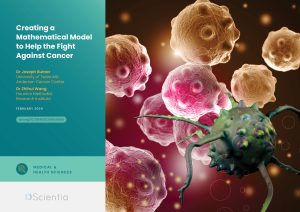Dr Joseph Butner – Dr Zhihui Wang | Creating a Mathematical Model to Help the Fight Against Cancer
Developing new ways to tackle cancer is an ongoing challenge for scientists. Recently developed immunotherapy treatments can use the patient’s own immune system against the cancer, but unfortunately, these are not effective for all patients. Dr Joseph Butner from the University of Texas MD Anderson Cancer Center and Dr Zhihui Wang from the Houston Methodist Research Institute have created a mathematical model to help doctors predict patient outcomes with these treatments and, in turn, offer personalised cancer therapies.
Stepping Up the Battle Against Cancer
Cancer is one of the leading causes of death. According to the World Health Organization, cancer caused almost one in six deaths in 2020 – around 10 million deaths globally. The word ‘cancer’ is used as an umbrella term since it is not a single disease but a group of diseases that can affect any part of the body. In general, cancer cells have a common feature in that they are fast-growing abnormal cells that can grow past their regular boundaries and metastasise (spread) to other areas. The location of the cancer and the level of progression, in turn, dictate what treatments can be used.
Immunotherapy utilises the patient’s own immune system to tackle the cancer. These treatments work by changing how the immune system cells work so they can locate and attack the cancerous cells. This kind of therapy has had excellent results, but unfortunately, some patients do not respond to the treatment. Being able to identify such patients could improve their outcomes, as alternative medicines could be used much earlier in the progression of the disease.
Dr Joseph Butner and Dr Zhihui Wang carry out their ground-breaking research as part of the Institute for Data Science in Oncology at MD Anderson Cancer and the Mathematics in Medicine Program at the Houston Methodist Research Institute, along with the Departments of Radiation Oncology and Imaging Physics at the University of Texas MD Anderson Cancer Center. Together, they have created a mathematical model to help doctors determine which patients would benefit from immunotherapy treatment with checkpoint inhibitors.
Immune Checkpoint Inhibitors
Immune checkpoint inhibitors are often more simply known as checkpoint inhibitors. They are a type of immunotherapy that works by switching off the molecular mechanisms cancer cells use to evade detection by the immune system. They bring a valuable new weapon to the fight against cancer, and as an added benefit, they are associated with fewer side effects than traditional therapies like chemotherapy and radiation.
The immune system can usually tell the difference between normal, healthy body cells and cells that are foreign to the body, such as harmful germs. Once unwanted cells are identified, the immune system can attack and destroy them. The immune system has complex ways in which it achieves this, but one way is by using checkpoint proteins on T-cells, which are a type of immune cell. These proteins act like switches and are turned ‘on’ or ‘off’ in order to start or stop a response from the T-cells.
Because cancer cells originate from the patient’s own cells, they are able to produce checkpoint proteins that cause them to appear to the immune system like normal, healthy cells. Some cancer cells take advantage of this to avoid being recognised by producing large amounts of the proteins that switch off the T-cells. Checkpoint inhibitors target these proteins, blocking them from switching off the T-cells so they can continue to do their job of destroying any cancer cells.
Immunotherapy is very effective against certain types of cancers and has even shown excellent success in treating cancers such as late-stage melanoma, which previously had been very difficult to treat and had a high mortality rate. Unfortunately, patients with some other forms of cancer are unresponsive to checkpoint inhibitors, with more than 50% failing to respond to this kind of treatment.
A Clinical Conundrum
Clinicians can be faced with a difficult situation when it comes to checkpoint inhibitor therapy. Time is of the essence with cancer, and outcomes are far better with earlier diagnosis and treatment. If a patient is first treated with one or more checkpoint inhibitors but fails to have a positive therapeutic response, it gives the cancer an advantage by allowing it more time to grow and spread, and may rule out other treatment options in the process. Even with patients who do respond, this tends to happen more slowly compared with traditional treatment options, making it hard to distinguish between patients who will have a favourable prognosis and those who are not going to respond to treatment and, therefore, need alternative management.
Importantly, several biomarkers have been identified that can help determine the likely effectiveness of checkpoint inhibitor treatment. A biomarker is a measurable quantity that is associated with, and therefore may be indicative of, a disease state or outcome, and can thus be used by doctors to make better clinical decisions.
There are many known biomarkers for cancer cells; for example, they can be tested to see if they produce sufficiently large amounts of checkpoint proteins to make treatment with a particular checkpoint inhibitor more likely to be effective. For example, if the expression levels (production) of the PD-L1 protein (programmed death ligand) are high enough, then the PD-L1 inhibitor pembrolizumab (a checkpoint inhibitor) could be administered. Nonetheless, this is not a 100% guarantee that it will be effective, as cancer cells can be very complex, and other factors often come into play. Additionally, proteins on cancer cells can be difficult to measure, as this requires invasive biopsies that are unpleasant for the patient and may not even be possible, depending on the location of the tumour.
Drs Butner and Wang have shown their model can also
be used based on medical imaging alone, which is already collected in standard clinical practice and allows patients
to avoid additional invasive procedures.
Quantifying Sensitivity to Checkpoint Inhibitors
Together with their collaborators, Dr Butner and Dr Wang created a mathematical model to quantify a patient’s sensitivity to checkpoint inhibitors and long-term tumour burden (the amount of cancer in the body predicted at some future time after treatment with checkpoint inhibitors). It focused on the time course of tumour responses to the treatment by taking into account a number of factors relating to tumour growth and the immune system, including intrinsic tumour growth rates, rates of immune activation, and tumour-immune cell interactions.
The model was tested for a total of 124 patients, two types of checkpoint inhibitors, and four different types of cancer. The team reported that their mathematical model was able to reliably describe the immune system responses and the final tumour burden for all the different cancer types and drug treatment combinations examined. They used validation cohorts from previous clinical trials to help evaluate the performance of the model, which consisted of 177 patients in total, and their model was able to accurately group patients according to their increased or reduced long-term tumour burden.
Dr Butner and Dr Wang were also able to use the model to derive quantitative measurements of the sensitivity to treatments for different types of cancer and drug combinations. They concluded their model could be used to predict responses to checkpoint inhibitor treatment and to quantify certain drug and cancer sensitivities on an individual patient basis.

Valuable Insights into Pseudo-Progression
Dr Butner and Dr Wang continued to rigorously challenge their model. They applied their tool retrospectively to 245 patients from several different clinical trials treated with the checkpoint inhibitors anti–CTLA-4 or anti–PD-1/PD-L1 antibodies. It was able to identify patients with both common and rare types of cancers who benefited or did not benefit from these treatments with a high level of accuracy.
Medical imaging can be used to help monitor tumour progression and response to treatment. Pseudo-progression describes a situation when a tumour appears to have worsened or progressed (that is, grown substantially larger in a short time after the therapy is started) in the scans but is, in fact, improving with the treatment. This is thought to be due to inflammation around the tumour caused by the treatment whilst it does its job. This is challenging for clinicians because these tumours are indistinguishable from those that are truly growing when examined via medical imaging.
The mathematical model also successfully identified the pseudo-progression of tumours from true progression. The team highlights that this offers previously unidentified insights into the biological and physiological characteristics of pseudo-progression, further mapping response patterns of individual patients and paving the way for personalised cancer therapies.
Three Key Parameters
Dr Butner and Dr Wang explain that their translational mathematical model is dependent on three key parameters for describing the effectiveness of checkpoint inhibitors. These are tumour growth rate, tumour-immune infiltration (a function of the strength and health of the immune system), and immune-therapy-mediated amplification of anti-tumour response (this may be thought of as the kill rate of the tumour by T-cells, which is caused by the checkpoint inhibitor therapy).
These are represented in the series of complex mathematical equations which make up the model, as the Greek letters α, Λ, and µ, respectively. These model parameters can be determined for each patient using non-invasive medical imaging or biopsy samples from their tumour, a procedure carried out at the start
of treatment.
The model was calibrated using data about clinical tumour response from 189 patients from published clinical trials on anti-PD-1 and anti-PD-L1 checkpoint inhibitors. The team then further validated their equations on an additional group of 64 patients from their own clinical trials. They found that the parameters Λ and µ (the state of the patient’s immune system and T-cell kill rate of cancer cells, respectively) were both significantly different between patients responding to treatment and those who did not. Most noteworthy, the model was able to classify response in 81.4% of the patients using only tumour volume measurements and within two months of starting treatment when the data were analysed retrospectively.
Dr Butner and Dr Wang concluded that their model can reliably predict clinical responses to PD-1, PD-L1, and CTLA-4 checkpoint inhibitors across different types of solid malignant tumours, and that their model parameters may offer robust biomarkers of the efficacy of these treatments.
The Protocol and Beyond
Dr Butner and Dr Wang later published a protocol for mathematical prediction of solid tumour response to checkpoint inhibitors and patient survival, using data gathered from tumour imaging. Here, they described the step-by-step process for collecting and processing the data required for the model and approaches for maximising the precision. They also made the code to use the model freely available.
This reliable model gives clinicians valuable insights into how a patient’s cancer will most likely respond to checkpoint inhibitor treatment, the closest thing to a ‘crystal ball’ we can get. More importantly, those who are unlikely to respond to the treatment can be identified earlier than typically possible, so different medicines can be offered, allowing cancer therapies to be tailored to the individual patient.
SHARE
DOWNLOAD E-BOOK
REFERENCE
https://doi.org/10.33548/SCIENTIA1008
MEET THE RESEARCHERS

Dr Joseph Butner
MD Anderson Cancer Center,
Houston,
TX, USA
Dr Butner is an Assistant Professor in the Department of Radiation Oncology and the Institute for Data Science in Oncology (IDSO) at the University of Texas MD Anderson Cancer Center, and he also holds adjunct professor positions at the Houston Methodist Research Institute and the University of St. Thomas, both of which are located in Houston, Texas, USA. His area of specialisation is integrating mathematical modelling, statistics, and data science with clinical measures to discover ways to predict disease outcomes and design personalised treatment, with a focus on cancer therapy. Currently, his work is focused on hybridising different predictive methods to predict patient survival in order to engineer treatment plans that optimise an individual patient’s desired therapeutic outcome. Dr Butner is fortunate to hold a primary appointment within a clinical department, which is rare among dry-lab researchers and facilitates his direct collaboration with leading oncologists. His long-term goal is that these collaborations will lead to the meaningful clinical integration of predictive mathematical modelling and calculated biomarkers for improved personalised medicine.
 CONTACT
CONTACT
faculty.mdanderson.org/profiles/joseph_butner.html

Dr Zhihui Wang
Houston Methodist Research Institute
Houston,
TX, USA
Dr Wang is a Professor in the Department of Medicine at the Houston Methodist Research Institute. He is a leading expert in the fields of multiscale cancer modelling, biophysical modelling of nanoparticle-based drug transport, and mechanistic modelling of cancer treatment prediction and optimisation. His research focuses on the integration of mathematical, engineering, and statistical methods with experimental investigations and patient data analysis. The goal of his research is to translate these mechanistic models into clinic applications for helping front-line physicians determine more effective, patient-specific drug treatment schedules beyond the current standard of care.
 CONTACT
CONTACT
www.houstonmethodist.org/faculty/zhihui-wang/
 FUNDING
FUNDING
This work was supported by grants from the National Institute of Health and
the National Science Foundation.
 FURTHER READING
FURTHER READING
JD Butner, GV Martin, Z Wang, et al., Early prediction of clinical response to checkpoint inhibitor therapy in human solid tumors through mathematical modelling, eLife, 2021, 10, e70130. DOI: https://doi.org/10.7554/eLife.70130
JD Butner, Z Wang, D Elganainy, et al., A mathematical model for the quantification of a patient’s sensitivity to checkpoint inhibitors and long-term tumour burden, Nature Biomedical Engineering, 2021, 5(4), 297–308. DOI: https://doi.org/10.1038/s41551-020-00662-0
JD Butner, M Farhat, V Cristini, et al., Protocol for mathematical prediction of patient response and survival to immune checkpoint inhibitor immunotherapy, STAR Protocols, 2020, 3(4), 101886. DOI: https://doi.org/10.1016/j.xpro.2022.101886
JD Butner, D Elganainy, CX Wang, et al., Mathematical prediction of clinical outcomes in advanced cancer patients treated with checkpoint inhibitor immunotherapy, Science Advances, 2020, 6(18), eaay6298. DOI: https://doi.org/10.1126/sciadv.aay6298



REPUBLISH OUR ARTICLES
We encourage all formats of sharing and republishing of our articles. Whether you want to host on your website, publication or blog, we welcome this. Find out more
Creative Commons Licence (CC BY 4.0)
This work is licensed under a Creative Commons Attribution 4.0 International License. 
What does this mean?
Share: You can copy and redistribute the material in any medium or format
Adapt: You can change, and build upon the material for any purpose, even commercially.
Credit: You must give appropriate credit, provide a link to the license, and indicate if changes were made.
SUBSCRIBE NOW
Follow Us
MORE ARTICLES YOU MAY LIKE
Dr Ralf Adam | New Technologies Shaping the Future of Oral Hygiene
Understanding the efficiency of various toothbrush technologies is essential for achieving optimal oral health. Dr Ralf Adam, who leads a dedicated team at Procter & Gamble in Germany, is keen to investigate the complexities of these technologies. His team have provided new insights into the best toothbrush types for plaque removal and the maintenance of gum health. By highlighting the importance of informed oral care decisions and ongoing investigations, this vital research works towards ensuring everyone can achieve a brighter, healthier smile.
Dr Toby Phesse | Revealing the Mysteries of Wnt Signalling: Novel Approaches to Beating Cancer
Cancer remains a leading cause of mortality worldwide, and the need for new, more effective treatments remains an urgent challenge. Dr Toby Phesse from Cardiff University in the UK focuses on the role of the Wnt receptor found on the surface of cells and its involvement with cell communication and cancer growth, bringing fresh hopes for new therapeutic options.
Dr Vijay Reddy | The Virus World Database: An Invaluable Resource for Public Health and Healthcare
Severe viral disease presents an ongoing challenge to the health of humankind. While unparalleled developments in science and technology are improving our understanding of such viruses, this information needs to be readily accessible to researchers to ensure continued progress in public health and healthcare. Dr Vijay Reddy and his colleagues at the Hormel Institute (University of Minnesota) developed the Virus World database, an invaluable resource that details the genome, structure, and host of practically every discovered virus to date.
Professor Ralf Herwig | Deciphering the Enigma of Vitamin D and the Immune System
Vitamin D has been studied as a treatment for a large number of diseases and conditions, from cancer to autism to COVID-19. However, its mode of action is not completely understood. Professor Ralf Herwig carries out his research at HG Pharma GmbH (Austria) and Ulster University (UK). His vital work explores the role of vitamin D in the body with a view to unlocking its potential as a treatment for a variety of health conditions involving the immune system.





